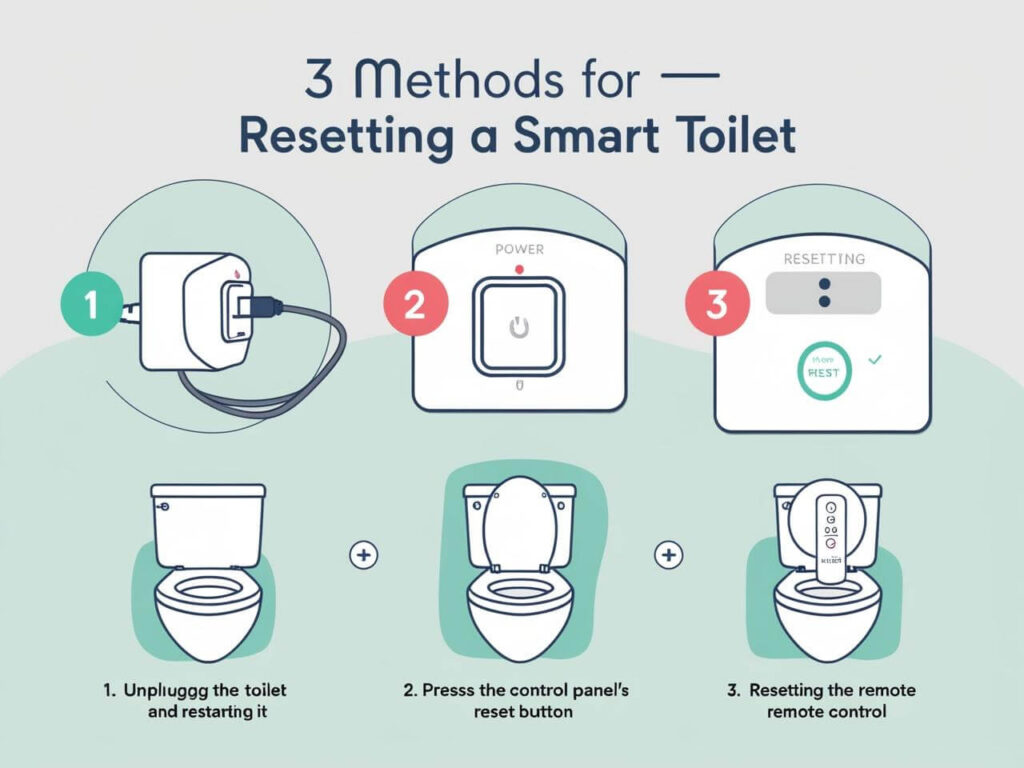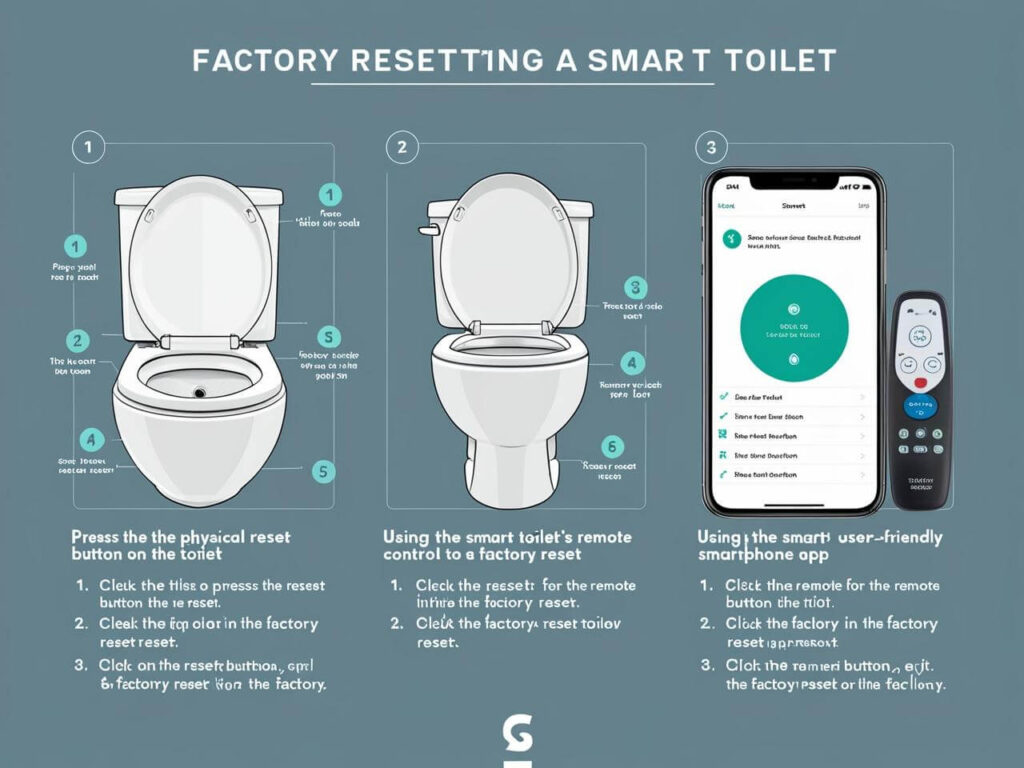16 min read
Your smart toilet is more than just a bathroom upgrade—it’s a high-tech helper designed to make your life easier and cleaner. But to keep it running smoothly, you need the right maintenance tips.
Ignoring simple care steps can lead to costly repairs or loss of those amazing features you love. You’ll discover easy and effective smart toilet maintenance tips that save you time, money, and hassle. Ready to protect your investment and enjoy your smart toilet at its best?
Keep reading!
Daily Cleaning Habits
Keeping your smart toilet clean every day helps it work well. Daily cleaning stops dirt and germs from building up.
Small daily actions protect your toilet and make it last longer. These habits keep your bathroom fresh and hygienic.
Choosing The Right Cleaner
Pick a cleaner that is safe for smart toilets. Avoid harsh chemicals that can damage sensors and parts.
Use mild cleaners or those made for electronic toilets. Check the label to ensure it is safe for your model.
- Avoid bleach and strong acids
- Choose pH-neutral cleaners
- Use soft, non-abrasive formulas
Wiping Surfaces Properly
Use a soft cloth to clean the toilet surfaces. Wipe gently to protect sensors and screens from scratches.
Clean all parts, including the seat, lid, and control panel. Dry surfaces after wiping to avoid water spots.
- Use microfiber cloths for best results
- Wipe in one direction to avoid streaks
- Do not spray cleaner directly on electronics
Preventing Odors
Flush the toilet fully after each use to keep it clean. Regular flushing reduces smell and bacteria growth.
Keep the toilet dry and ventilated. Use air fresheners or deodorizing tablets made for smart toilets if needed.
- Flush twice if needed
- Leave the lid open after cleaning
- Use natural air fresheners

Credit: techobath.com
Regular Inspection
Smart toilets need regular checks to work well. Inspections help find small problems early.
Regular inspection keeps your toilet clean and saves water. It also prevents costly repairs.
Checking Sensors And Controls
Sensors control many smart toilet features. Check them often to make sure they work well.
Clean sensor areas gently. Dirt or dust can stop them from working properly.
- Wipe sensors with a soft cloth
- Test automatic flush and seat functions
- Replace batteries if needed
Monitoring Water Usage
Smart toilets track water use to save resources. Watch your water levels to spot issues.
Compare your water use regularly. Sudden changes could mean a problem or leak.
- Check water meter numbers each week
- Look for unexpected water use spikes
- Adjust settings to save more water
Identifying Leaks Early
Leaks waste water and damage floors. Find leaks as soon as possible to avoid bigger issues.
Look for water around the base or inside the toilet. Listen for sounds of running water.
- Check toilet base for dampness
- Listen for constant running water
- Test flush valve and water connections
Filter And Nozzle Care
Smart toilets need regular care to work well and last long. Clean filters and nozzles keep water fresh and spray accurate.
Taking simple steps to maintain these parts helps avoid problems and keeps your toilet hygienic.
Cleaning Water Filters
Water filters stop dirt and particles from entering the smart toilet system. Clean filters often to avoid blockages.
Remove the filter gently and rinse it under running water. Avoid using harsh chemicals that can damage the filter.
- Turn off the water supply before removing the filter
- Use a soft brush to remove stuck dirt
- Rinse thoroughly with clean water
- Let the filter dry completely before reinstalling
Maintaining Bidet Nozzles
Bidet nozzles spray water for cleaning and need regular care. Clean nozzles prevent clogging and keep spray smooth.
Wipe nozzles with a soft cloth and mild soap. Some models have a self-cleaning feature; use it often.
- Check nozzle position and adjust if needed
- Remove mineral deposits with vinegar if buildup occurs
- Do not use sharp tools to clean nozzles
- Run the self-cleaning cycle weekly if available
Replacing Filters When Needed
Filters wear out over time and must be replaced to keep the toilet working well. Watch for signs of clogging or bad smell.
Check the user manual for filter replacement schedules. Use only recommended filters to avoid damage.
- Replace filters every 6 to 12 months
- Use genuine replacement parts for best fit
- Dispose of old filters properly
- Keep spare filters handy to avoid delays

Credit: techobath.com
Software Updates
Smart toilets need regular software updates to work well. Updates fix bugs and add new features.
Keeping your smart toilet’s software current improves its performance and security.
Connecting To Wi-fi
Connecting your smart toilet to Wi-Fi lets it download updates automatically. A strong signal is important.
Use your phone or remote to find your home Wi-Fi network. Enter the password carefully to connect.
- Check Wi-Fi signal near the toilet
- Open the toilet’s settings menu
- Select your Wi-Fi network
- Enter the correct password
- Confirm connection success
Installing Latest Firmware
Firmware is the software inside your smart toilet. Installing the latest version keeps it updated.
Most smart toilets check for updates automatically. You can also update manually from the settings menu.
- Go to the update section in settings
- Check for available updates
- Download and install updates
- Do not turn off the power during update
- Restart the toilet if needed
Troubleshooting Common Issues
If updates fail, check your Wi-Fi connection first. Sometimes restarting the toilet helps.
Clear cache or reset network settings if problems continue. Contact support if issues remain.
- Ensure Wi-Fi is strong and stable
- Restart the smart toilet
- Reset network or update settings
- Try manual update again
- Contact customer support if needed
Power And Battery Tips
Smart toilets use electricity or batteries to work well. Keeping their power steady helps avoid problems.
Good power care can save money and keep your toilet ready to use all the time.
Ensuring Stable Power Supply
Make sure your smart toilet is plugged into a safe, steady power source. Avoid using loose or damaged cords.
Check your outlet for any signs of wear or sparks. A stable power source helps your toilet work without interruption.
- Use grounded outlets to prevent electrical issues
- Avoid power strips with many devices connected
- Keep the area dry to avoid electrical shorts
- Inspect cords regularly for damage
Managing Battery Life
If your smart toilet uses batteries, check them often. Replace old batteries to keep the toilet working well.
Use batteries recommended by the manufacturer. This helps avoid leaks or poor performance.
- Replace batteries before they run out completely
- Remove batteries if you won’t use the toilet for a long time
- Store spare batteries in a cool, dry place
- Use high-quality batteries for longer life
Using Energy-saving Modes
Many smart toilets have energy-saving modes. These reduce power use when the toilet is not in use.
Turn on energy-saving mode to save electricity and lower your bills. It also helps the battery last longer.
- Activate sleep mode during night hours
- Set automatic shutoff for unused times
- Use low-power settings if available
- Check the user manual for energy-saving tips
Preventive Measures
Smart toilets need regular care to work well for a long time. Taking steps to protect them helps avoid problems.
Simple actions can keep your smart toilet clean and safe. These tips focus on stopping damage before it starts.
Avoiding Harsh Chemicals
Harsh chemicals can damage smart toilet parts. They may harm sensors, seals, and the toilet surface.
Use mild cleaning products made for smart toilets or gentle bathroom cleaners. Avoid bleach or strong acids.
- Choose pH-neutral cleaners
- Do not use abrasive scrubbers
- Wipe surfaces with a soft cloth
Keeping Electrical Parts Dry
Water and electricity do not mix well. Keep the smart toilet’s electrical parts dry to avoid damage.
Do not spray water directly on sensors or control panels. Use a dry cloth to clean these areas.
- Turn off power before cleaning electrical parts
- Check seals around electrical areas regularly
- Fix leaks quickly to prevent water contact
Scheduling Professional Servicing
Experts know how to keep smart toilets working well. Regular checks help find and fix issues early.
Set up service visits once or twice a year. Professionals clean, test, and adjust your smart toilet parts.
- Ask for sensor calibration
- Request inspection of electrical systems
- Ensure all mechanical parts are lubricated

Credit: horow.com
Frequently Asked Questions
How Often Should I Clean A Smart Toilet?
Clean your smart toilet at least once a week. Regular cleaning prevents buildup and maintains hygiene. Use gentle, non-abrasive cleaners to avoid damaging sensors or surfaces. Follow the manufacturer’s instructions for specific cleaning tips.
What Products Are Safe For Smart Toilet Maintenance?
Use mild, non-abrasive, and pH-neutral cleaners. Avoid bleach, ammonia, or harsh chemicals that can harm sensors or finishes. Microfiber cloths work well for wiping surfaces without scratching. Always check your toilet’s manual for recommended products.
How Can I Prevent Clogging In Smart Toilets?
Avoid flushing non-flushable items like wipes or feminine products. Use the self-cleaning feature if available to reduce residue buildup. Regularly check and clean the toilet’s filter or trap to maintain smooth drainage.
Can I Perform Smart Toilet Maintenance Myself?
Yes, basic maintenance like cleaning and filter checks are DIY-friendly. However, for complex issues or repairs, contact a professional or the manufacturer. Regular self-maintenance extends your toilet’s lifespan and ensures optimal performance.
Conclusion
Caring for your smart toilet is simple with regular attention. Clean regularly to prevent build-up and ensure efficiency. Check for leaks often, saving water and money. Use gentle cleaners to protect surfaces and parts. Follow the manufacturer’s guide for specific maintenance needs.
Smart toilets offer convenience, but need some care. Keep it running smoothly with these easy tips. Enjoy a hassle-free experience and a well-maintained bathroom. Regular checks and simple cleaning go a long way. A little effort ensures your smart toilet stays in top shape.
Happy flushing!

